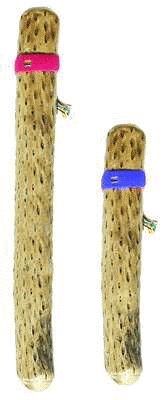Instruments


Sikus o Zamponias-Rondador-Zanka-Quenas-Tarkas
Siku: Not to be mistaken for the European panflute, the siku (in
Quechua and Aymara) or zampo�a (in Spanish), is a cane
panpipe native to the highlands surrounding lake Titicaca,
between Per� and Bolivia.
The siku has two separate rows of pipes open at one end
and closed at the other, with each row containing every
other note of the musical scale. Usually, there is a row of
six pipes, called the ira, and one of seven, known as the
arca. The pipes are held in place by two or more straps,
also made of cane, running across the width of the
instrument, and by threads or cloth braided between the
pipes and attached to the straps. Present-day sikus are
made from highland bamboo and from chuqui, a cane
found in the outskirts of many Peruvian forests. In Bolivia, a
cane called zongo is also used. In ancient times, sikus
were also made of clay or stone.
*********
Quena:
The quena is an Andean instrument of pre-millenerian
origin. Thanks to its musical flexibility (being so adaptable
and tunable in so great a variety of ways), it holds a
position of substantial prominence. It can be made of
wood or bamboo, though its ancestors were also made of
clay, stone and bone, especially the wing bones of the
condor.
The quena is a vertical flute, tubular in shape, open at both
ends, with a U-shaped mouthpiece that is placed at the tip
of the lower lip when blowing air to produce sound. It has
six finger-holes in front and one in the back. Quenas are
available in a variety of sizes, according to purpose and to
local customs.

Charango
The charango is a small ten string lute that originated in South America. The back of the instrument is traditionally fashioned from an armadillo. When the Spaniards came to South America, they brought the vihuela (an ancestor of the guitar) with them. The native people liked the vihuela, but lacked the technology to shape the wood in that manner. However, there was a convenient resource available to them: armadillo shells. Thus the charango was born. Today, many of the best charangos have wooden backs instead of employing armadillo shells.

Bombo
A cylindrical shaped drum found in the Andean region and popular in the styles found in Argentina, Chile, Bolivia and Peru. The drum is played with a stick and a mallet which strike the wooden rims and the head. The body of the drum is made out of a hollow tree, with the mounted skins retaining the animal's fur, thus producing a very distinctive mellow and deep tone

Rain Stick
The Rainstick (Palo de Lluvia), or Waterstick (Palo de Agua), is a musical and ceremonial instrument used in many communities from ancestral times to the present. Its name is descriptive of the sound of falling rain the instrument produces. Rainsticks are made only from dead cacti, found predominantly in the desert zones of Northern Chile. The thorns of the cactus branch are pressed into the hollow shaft to form a spiral pattern. Filled with desert pebbles, the rainstick produces its characteristic sound when it is tilted to allow the pebbles to run through its interior.
Home About Aconcagua Picture Galery Upcoming Events
Links Order Your CD